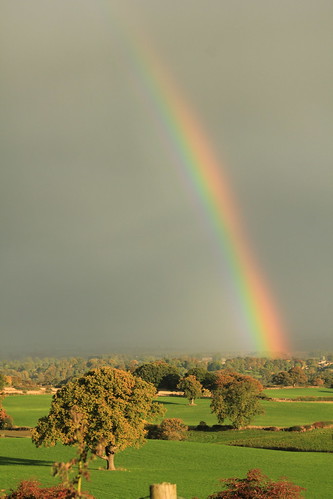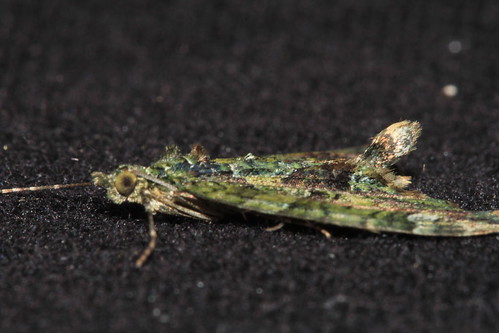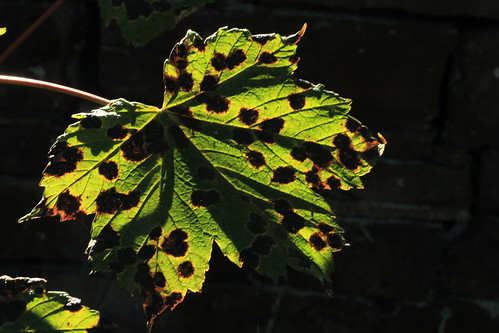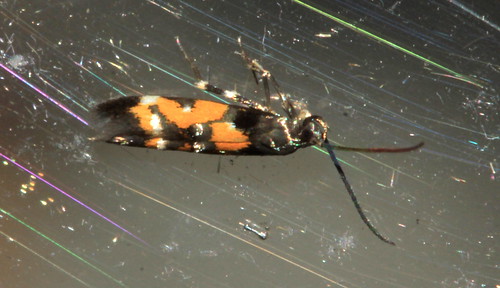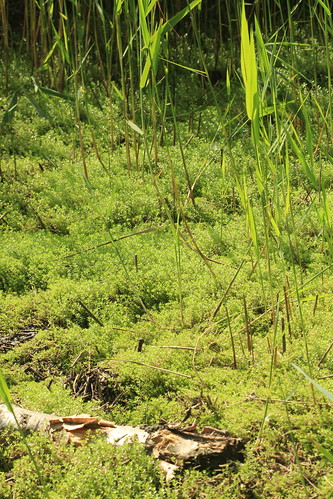Channelled Wrack -
Pelvetia canaliculata
The next photo works well as an art shot, as well as a record of what I found. It has a few seaweeds in it.
The one top is Channelled Wrack, at the bottom is a orange coloured"strap-like" one, which I've not been able to ID so far. There is a little Sea Lettuce on the top right. On top of the Orange one is Bladder Wrack Fucus vesiculosus. The latter seaweed has round air bladders which float its fronds towards the light. They usually grow in pairs on either side of the mid-rib. This seaweed needs photosynthesis to produce food for itself, (sugars). On wave exposed shores, a bladder-less form occurs.
The number of bladders present varies with wave action. With
increasing wave action the number of bladders decline. The reproductive structures at the ends of
the frond (the receptacles) become elongated and narrow. These changes
are essentially to reduce the drag on the alga.
Lifespan: 4 to 5 years.
Habitat: typically in the middle shore.
Length: 1m although up to 2m have been recorded.
Multiple Seaweeds.
Now for
Sugar Kelp -
Saccharina latissima.
Sugar Kelp (or 'Sugar Wrack') is a common kelp seaweed which grows around the low water mark, attached to rocky shores up to 30 metres deep. It favours sheltered conditions. It can live for up to four years and grows particularly quickly during early spring. Sugar Kelp is sweeter than other kelps, so is used in cooking from Scotland to Japan.
Sugar Kelp is a large seaweed, dark browny-green, with a single, broad frond that has a distinctive crinkly and wavy edge. This kelp make a special sugar caller "lanminarin".
May be confused with Dabberlocks -
Alaria esculenta, which has a distinctive midrib. Sugar Kelp does not have a rib.
Size: Length: 4m.
Frond width: over 15cm.
Habitat: Common on rocky shores all around our coasts. Found as far as 30 metres deep. It favours sheltered conditions.
Lifespan: 4 years. It grows very quickly in early spring.
Common Names: Sweet Kelp, Kombu Royale, Sugar Kelp, Sea Belt, Poor Man’s Weather Glass.
Sugar Kelp - Saccharina latissima.
The following one is
Eelgrass it is not a seaweed - it's a perennial flowering plant.Eelgrass is a type of submerged aquatic vegetation, referred to as SAV.
Seagrasses are the only flowering plants that are able to live in seawater and able to pollinate while submerged. Seagrass ecosystems are among the most diverse and productive ecosystems in the world. In ecological and economic value, they rival tropical rainforests and the world's richest farmlands.
Eelgrass beds form dense underwater meadows providing food, shelter and protection from predators for many juvenile fish and shellfish of ecological, commercial and recreational importance. Seagrass beds also play an important role in the life cycles of crabs, finfish, and waterfowl. There are four species in the UK, two species of
tasselweeds and two
zostera species known as
eelgrass.
Habitat: Seagrass is dependent on high levels of light for photosynthesis to grow and can therefore only be found in shallow water to a depth of around 4m. They are found around the coast of the UK, in sheltered areas such as harbours, estuaries, lagoons and bays. Also found around the world in temperate climates.
Common eelgrass - zostera marina.
The next seaweed is Egg wrack - Ascophyllum nodosum. On one site I looked at is is described as, "a large, common brown alga". The accompanying photo showed it as green and my photos all show a yellow seaweed. Be warned, the colours seem to vary a lot. It is the only species in the genus Ascophyllum. It's seaweed of the northern Atlantic Ocean, also known as Rockweed, Norwegian kelp, knotted kelp or knotted wrack.
This seaweed contains Phlorotannins, which act as chemical defenses against the marine herbivorous snail, Littorina littorea. Because the age of the different parts of A. nodosum can be identified by its shoots, A. nodusum has also been used to monitor concentrations of heavy metals in sea water.
Habitat: Common on the north-western coast of Europe (from Svalbard to Portugal) including east Greenland and the north-eastern coast of North America.
Length: 2 m
Lifespan: 10-15 years
Growth rate: Slow, 0.5% a day.

Egg wrack - Ascophyllum nodosum.
Now for an orange seaweed. I have been trying to get an ID on the next seaweed for almost two weeks and failed miserably. I show it here because it is at least recorded, also because it's an unusual colour compared to the rest of them I saw. There was a fair amount of it about, so it's not rare, as far as I can tell. From what I have learned, my guess is that it is a kelp of some kind, it's only a guess as I said. The second photo shows the full length of another piece of the same seaweed.
Species unknown.
Species unknown.
Below are two images of what I suspect are the same seaweed. It's white because it has been bleached in the sun and rain as far as I can tell. Certainly, I have found no white seaweeds and I have devoted a large part of the last two weeks researching seaweed. I'm as sure I can be that this one is Chondrus crispus - Carragheen (TBC).
As I'm not totally sure of the ID, I will not give comment on it.
I do have one thing to point out here; look at the bottom right of the second image, you'll see a net like object. It's Sea Mat - Bryozoa.
This is not a seaweed, they are actually animals that live in limy chambers. They are minute organisms which form flat colonies over the surfaces of seaweeds and under rocks. They filter the seawater for food and are hermaphrodites.
Chondrus crispus -
Carragheen (TBC).
Chondrus crispus and Sea Mat.
Whilst I'm talking about tiny sea animals, I may as well show you two more. First, Calcareous Tube Worm - spirobis spirobis on Seaweed. The tube they live in are fixed to the rock so they can't move about. When the tide is in, they put their heads out and feed on tiny particles in the water.
Calcareous Tube Worm -
spirobis spirobis
Next, the
Keel Worm Pomatoceros triqueter. There are two keel worms. It took me a while to sort them out (easy once you know) The one shown below may be confused with
Pomatoceros lamarcki, the tube of which differs from
Pomatoceros triqueter as it has two vestigial ridges, one on each side, in addition to the median keel. It feeds in the same way as the
Calcareous Tube Worm.
Keel Worm Pomatoceros triqueter.
I've talked about seaweeds but not shown how the anchor to rock. Basically, they use what it called a Holdfast, which is different for different species of seaweed, some have a disk, others a root-like structure. the one below has the latter. The image also shows a few barnacles.
Seaweed Holdfast.
Now for the Twisted wrack - Fucus spiralis, also called Spiral wrack. It can be recognised by the spirally twisting fronds with an obvious rib down the middle, and the yellowish, paired swollen tips which are the reproductive structures. The bladders in this one are still inflating. It can survive out of the water for long periods, and live for four years.
Twisted wrack - Fucus spiralis
I have another white/bleached seaweed now. In places, you can still see the original brown colour that the whole weed was. I've only been able to narrow it down to one of two, it's either, the broken off fronds of Furbelows - Saccorhiza polyschieds, or, broken off fronds of Oar Weed - Laminaria hyperborea. Your guess is as good as mine.
Furbelows or, it may be Oar Weed.
To finish this post off, here is yet another white/bleached seaweed. It's a very delicate one and I believe it to be Polysiphonia lanosa. It is a red, threadlike seaweed which grows almost always on the seaweed, Knotted wrack - Ascophyllum nodosum. As yet, it is not clear what the relationship between Polysiphonia lanosa and Ascophyllum nodosum is. It could be parasitic, it may be symbiotic. There are about twenty other species of Polysiphonia that grow around the coasts of Britain.
Polysiphonia lanosa.
So, that's the end of my Arran seaweed post. It has been a long journey and steep learning curve for me, I have thoroughly enjoyed it. Although, I do have to admit that sometimes I became quite frustrated. I have complained about the lack of a dedicated seaweed book. However, after a great deal on online searching, I have found several very good PDFs about them.
I strongly recommend the Oxford Book of Flowerless Plants. This had the best selection of seaweeds I'd found anywhere.


